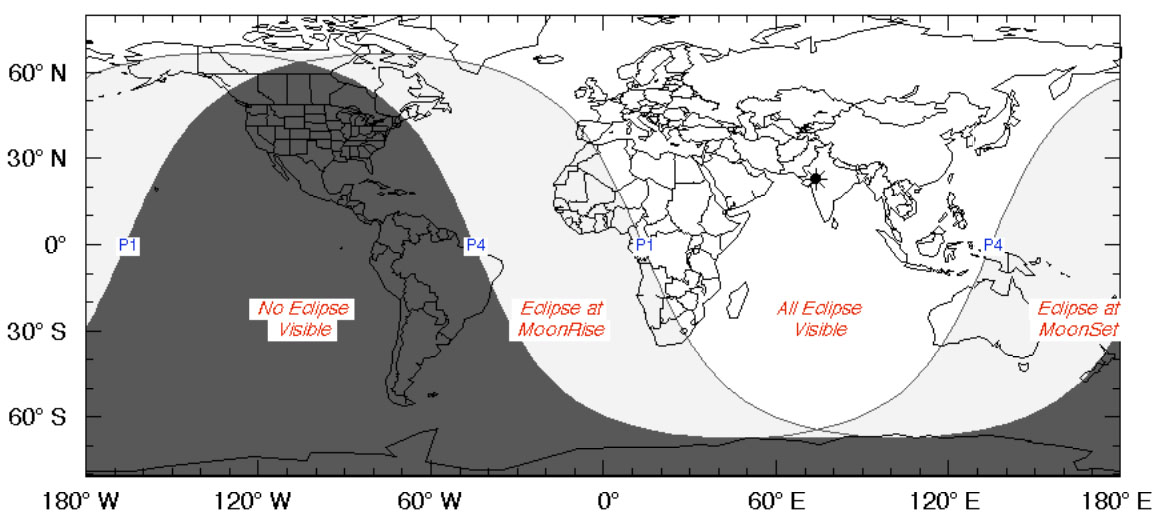Penumbral Lunar Eclipse Occurs Friday: Here's What to Expect
Update for 6 p.m. EST: The first lunar eclipse of 2020 has ended. You can see our full wrap story here, complete with stunning photos by Space.com readers here!
Next time you're outside on a bright, sunny day, take note that the shadow you're casting does not have a sharp edge. In fact, a diffuse penumbra surrounds most any shadow, unless the light is a point source.
A penumbral lunar eclipse is scheduled for Friday (Jan. 10). No part of the moon enters Earth's much darker umbra, as happens during a partial or total lunar eclipse. But on Jan 10-11 (depending on your location), just about the best penumbral eclipse possible will occur.
The lower portion of the moon will track deep into the Earth's outer shadow, and the natural satellite's southern limb will miss the Earth's umbra by only about 225 miles (360 kilometers), or nearly 10% of the moon's diameter. Although none of the moon will go dark, the penumbral shading will be very plain to see.
Watch Online: Wolf Moon Lunar Eclipse of 2020 Webcast Guide!
More: How Lunar Eclipses Work (Infographic)
Unfortunately, the eclipse will not be visible from most of North America, where the darkest phase will happen during the late morning to early afternoon hours, when the full moon will be out of sight below the horizon.
To get a good view of this eclipse, you would have to be located somewhere in the Eastern Hemisphere: Europe, Africa and western Asia will have a trouble-free view, with the moon ascending the east-northeast sky. Some small parts of North America — like Newfoundland, northern Canada and Greenland — will have a chance to see the end of eclipse, which begins before moonrise.
Breaking space news, the latest updates on rocket launches, skywatching events and more!
If you're not in the right place to see the eclipse, or if cloudy skies foil your view, you can watch the event live online. The Slooh community observatory will provide a webcast starting at 2:30 p.m. EST (1930 GMT), which you can watch live here on Space.com, courtesy of Slooh. Additionally, The Virtual Telescope Project will stream live views of the eclipse from Rome, beginning at 12 p.m. EST (1700 GMT).
A shady little drama
The outer part of Earth's penumbra, like the outer part of any penumbra, is so weak that it's difficult to spot from a great distance, such as when it's on the moon's surface. Even the sharpest of eyes will fail to detect anything happening until the moon's edge is at least halfway across the penumbra. For this event, that means about 65 minutes before mid-eclipse (which will come at 12:10 p.m. EST, or 1910 GMT).
Shading will begin on the left side of the moon. For some minutes around the time of mid-eclipse, the lower part of the moon will appear noticeably "smudged" or "soiled." The lopsidedness of the moon's illumination will be obvious. Compared to the Earth's umbra, which appears much darker and with a sharper edge, the penumbra appears more as a diffuse shading on the lunar disk. But that shading will become ever more sharply concentrated toward the southern limb.
After mid-eclipse, the process reverses. The last evidence of any shading should disappear about an hour later, with the moon reverting back to its normal self.
| Eclipse begins | 12:07 p.m. EST (1707 GMT) |
| Mid-eclipse | 2:10 p.m. EST (1910 GMT) |
| Eclipse ends | 4:12 p.m. EST (2112 GMT) |
| Magnitude | 0.8956 |
Here is a timetable for the eclipse. The "magnitude" refers to the fraction of the moon's diameter inside of the penumbra at the moment of maximum eclipse, which translates to about 89.6%
There will be three more penumbral lunar eclipses in 2020, on June 5, July 5 and Nov. 30. During the final one, the moon will penetrate deepest into the Earth's outer shadow to produce the most noticeable darkening on the moon's disk.
Editor's note: If you capture an amazing photo of the lunar eclipse and would like to share it with Space.com for a story or gallery, send images and comments to managing editor Tariq Malik at spacephotos@space.com.
- In Photos: The Snow Moon Lunar Eclipse & Comet 45P Close Encounter
- 'Ring of Fire' Solar Eclipse Thrills Skywatchers Around the World (and in Space, Too!)
- How to Catch the Next Eclipse: A List of Solar and Lunar Eclipses in 2020 and Beyond
Joe Rao serves as an instructor and guest lecturer at New York's Hayden Planetarium. He writes about astronomy for Natural History magazine, the Farmers' Almanac and other publications. Follow us on Twitter @Spacedotcom and on Facebook.


Joe Rao is Space.com's skywatching columnist, as well as a veteran meteorologist and eclipse chaser who also serves as an instructor and guest lecturer at New York's Hayden Planetarium. He writes about astronomy for Natural History magazine, Sky & Telescope and other publications. Joe is an 8-time Emmy-nominated meteorologist who served the Putnam Valley region of New York for over 21 years. You can find him on Twitter and YouTube tracking lunar and solar eclipses, meteor showers and more. To find out Joe's latest project, visit him on Twitter.

